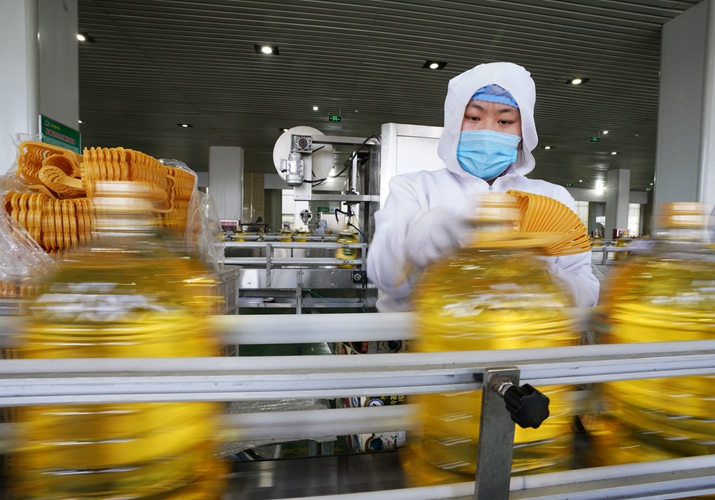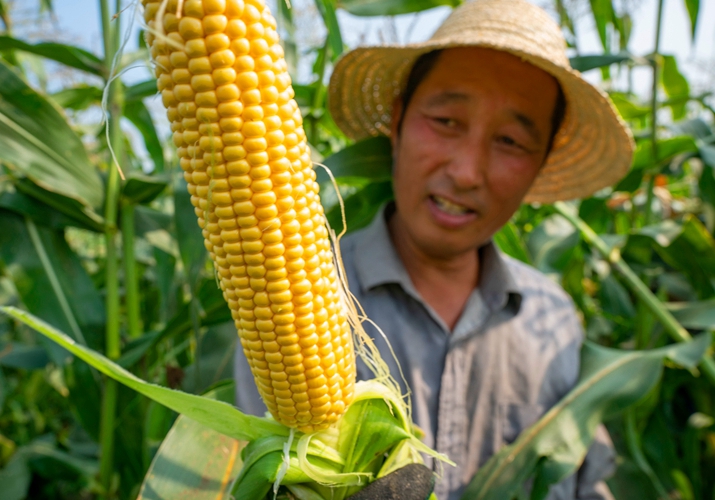|
||||||||||
| Home Nation World Business Opinion Lifestyle ChinAfrica Multimedia Columnists Documents Special Reports |
|
||||||||||
| Home Nation World Business Opinion Lifestyle ChinAfrica Multimedia Columnists Documents Special Reports |
| ChinAfrica |
| An expanding corn industry brings more income to poor villagers in China |
| In recent years, thanks to the various subsidies for agriculture, corn has played a vital role in raising farmers' income and alleviating poverty, besides contributing to food security |
| By Li Kaizhi VOL.12 September ·2020-09-14 |

A worker is busy on the production line of corn oil at Sanxing Group Co. Ltd. in Zouping City, Shandong Province in east China, on March 14 (XINHUA)
Dachazi porridge is a popular staple food in northeastern region of China. It is made by boiling the whole corn kernels with a handful of red kidney beans. In autumn when the corn is ripe, local people like to enjoy a bowl of sticky Dachazi porridge every day.
"The porridge made out of corn in our yard is really tasty," said Wang Guiyun, who has lived in Heilongjiang Province in northeast China, one of China's main corn producing areas, for 70 years. Wang is happy with the good harvest of corn of his family.
"This year has been a bumper year for agriculture, especially for the corn crop, while most industries have been hit by the COVID-19 epidemic," Wang said.
In recent years, thanks to the various subsidies for agriculture, corn has played a vital role in raising farmers' income and alleviating poverty, besides contributing to food security.
Cooperative model
Farmers' cooperative is a mutual-aid economic organization which is jointly managed by the farmers on the basis of household contract management. It is a fundamental organization connecting small farmers with the development of modern agriculture.
By the end of June, there were more than 2.2 million farmers' cooperatives, covering nearly half of the rural households across the country, according to the data from the Ministry of Agriculture and Rural Affairs of China.
Established in August 2010 in Wenquan County, Bortala Mongol Autonomous Prefecture in Xinjiang Uygur Autonomous Region in northwest China, Xinnong Corn Planting Cooperative is a comprehensive cooperative integrating production, sales and storage.
"This year, 461 poor households have transferred their land rights to the cooperative, and the cooperative is planning to plant 20,000 mu (1,333 hectares) of corn. We have already received orders for silage corn and waxy corn," He Tianshan, President of the cooperative, revealed. He said they have adopted the cooperative system over the years to solve the problem of employment for local poor households and help them shake off poverty.
Gao Tianping, a 46-year-old poor villager in Wenquan County and a member of the Xinnong Corn Planting Cooperative, has seen his family income greatly increase after joining the cooperative. "There is a monthly salary of 5,000 yuan ($717) and the cooperative also takes care of our 15 mu (1 hectare) of land, which can pay about 10,000 yuan ($1,441) in dividends each year. Combined with other sources, my family has a total income of more than 80,000 yuan ($11,472) a year," Gao said.
Since 2010, 42 members of the cooperative have received fixed dividends ranging from 3,000 yuan ($430) to 8,000 yuan ($1,147) a year depending on the size of their land contribution. In addition, the cooperative provides full-time employment to three poor villagers and hires more than 2,000 poor villagers each year for temporary work, increasing the income of poor households.
At the beginning of 2019, Xinnong joined hands with four other cooperatives to form an industrial consortium of agriculture and husbandry to concentrate its efforts on expanding the corn industry.
"Last year, the consortium adopted the circular agriculture development model, which includes corn planting and drying, and organic fertilizer processing. It has provided employment to 561 registered impoverished villagers from seven towns in the county. The annual number of workers employed by the consortium has reached 18,000, with an output value of more than 100 million yuan ($14.41 million)," according to He.
"Only when the industry is prosperous can there be a way to increase employment and income, and thereby support the comprehensive development of rural areas," noted Tang Hu, Deputy Director of the Bureau of Agriculture and Rural Affairs of Bortala Mongol Autonomous Prefecture. "We will continue to actively explore new paths for rural industrial development, so as to achieve a decisive victory in poverty alleviation," Tang added.

A farmer displays sweet corn that he has harvested in Zhangguanzhuang Village in Tangshan City, Hebei Province in north China, on July 16 (XINHUA)
Corporate engagement
The Wanquan District under Zhangjiakou, Hebei Province in north China, is known as sweet corn "golden belt." Of the 220,000 mu (14,667 hectares) of agricultural land in the district, more than 80,000 mu (5,333 hectares) is used for sweet corn plantation. The planting area spans five towns and covers more than 20,000 households in the region.
"Sweet corn requires higher technology than the ordinary variety, but we have guidance throughout the whole process, so it's easy for us to plant," said Zhang Zhenjin, a physically disabled poor villager living in Huojiafang Village of Wanquan District. He was hired by Zhangjiakou Suikang Fresh Development Co. Ltd. Now, he is responsible for the planting and management of 180 mu (12 hectares) of sweet corn in the village.
In order to support the development of the sweet corn industry, the government of Wanquan District has facilitated the establishment of the Sweet Corn Association as well as Hejiu Group. As the largest sweet corn enterprise in the district, Hejiu has 65,000 mu (4,333 hectares) of corn planting area, involving more than 1,100 households in cooperatives.
"We conduct at least two large-scale training sessions and four to five special training sessions for cooperative farmers every year, with the aim of turning them into 'technological farmers'," Zhang Zhanbing, Chairman of Hejiu Group, said, adding that this year they have introduced a new subsidy policy under which each household can get the fertilizer subsidy of 200 yuan ($28.8) per mu (0.067 hectare) as long as they participate in the training as required. "We must offer incentives to attract farmers to classroom," Zhang noted.
Thanks to these efforts, Wanquan's sweet corn industry has expanded its market share year by year. The products is sold to more than a dozen provinces and cities, and exported to more than 10 countries such as Japan and South Korea, which can increase the income of more than 20,000 households by 34.8 million yuan ($5 million) each year.
"In the future, the planting area of the sweet corn will reach 100,000 mu (6,667 hectares)," said Liang Zhonghe, Director of the Bureau of Agriculture and Rural Affairs of Wanquan District.
Extracting oil from corn germ; producing ethanol from corn straw; obtaining compound amino acids using corn flour… In addition to sweet corn and other primary corn processing enterprises, a growing number of deep processing enterprises in this industry are also helping to improve the added value of corn products, and actively helping impoverished people increase their income and shake off poverty.
Comments to likzh@chinafrica.cn
| About Us | Contact Us | Advertise with Us | Subscribe |
| Copyright Beijing Review All rights reserved 京ICP备08005356号-5 京公网安备110102005860号 |